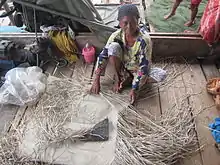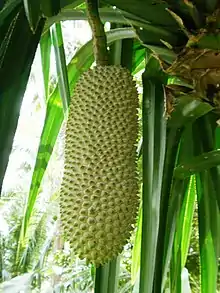Pandanus
Pandanus is a genus of monocots with some 750 accepted species.[2] They are palm-like, dioecious trees and shrubs native to the Old World tropics and subtropics. The greatest number of species are found in Madagascar and Malesia.[3] Common names include pandan[4] (/ˈpændən/),[5] screw palm,[4] and screw pine.[4] They are classified in the order Pandanales, family Pandanaceae.[6][7]
| Pandanus | |
|---|---|
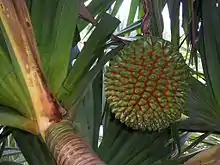 | |
| Fruit of Pandanus utilis | |
| Scientific classification | |
| Kingdom: | Plantae |
| Clade: | Tracheophytes |
| Clade: | Angiosperms |
| Clade: | Monocots |
| Order: | Pandanales |
| Family: | Pandanaceae |
| Genus: | Pandanus Parkinson[1] |
| Species | |
| Synonyms[1] | |
| |
Description
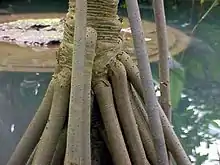
Often called pandanus palms, these plants are not closely related to palm trees. The species vary in size from small shrubs less than 1 m (3.3 ft) tall, to medium-sized trees 20 m (66 ft) tall, typically with a broad canopy, heavy fruit, and moderate growth rate.[9] The trunk is stout, wide-branching, and ringed with many leaf scars.[10] Mature plants can have branches.[10] Depending on the species, the trunk can be smooth, rough, or warty.[11][12] The roots form a pyramidal tract to hold the trunk.[13] They commonly have many thick stilt roots near the base, which provide support as the tree grows top-heavy with leaves, fruit, and branches.[14] These roots are adventitious and often branched. The top of the plant has one or more crowns of strap-shaped leaves that may be spiny,[6][7] varying between species from 30 cm (12 in) to 2 m (6.6 ft) or longer, and from 1.5 cm (0.59 in) up to 10 cm (3.9 in) broad.
They are dioecious, with male and female flowers produced on different plants. The flowers of the male tree are 2–3 cm (0.79–1.18 in) long and fragrant, surrounded by narrow, white bracts. The female tree produces flowers with round fruits that are also bract-surrounded. The individual fruit is a drupe, and these merge to varying degrees forming multiple fruit, a globule structure, 10–20 cm (3.9–7.9 in) in diameter and have many prism-like sections, resembling the fruit of the pineapple. Typically, the fruit changes from green to bright orange or red as it matures. The fruits can stay on the tree for more than 12 months.
Ecology
These plants grow from sea level to 3,300 m (10,800 ft). Pandanus trees are of cultural, health, and economic importance in the Pacific, second only to the coconut on atolls.[15][16] They grow wild mainly in semi-natural vegetation in littoral habitats throughout the tropical and subtropical Pacific, where they can withstand drought, strong winds, and salt spray. They propagate readily from seed, but popular cultivars are also widely propagated from branch cuttings by local people.[6]
Species growing on exposed coastal headlands and along beaches have thick 'stilt roots' as anchors in the loose sand.[6][17] Those stilt roots emerge from the stem, usually close to but above the ground, which helps to keep the plants upright and secure them to the ground.[14]
While pandanus are distributed throughout the tropical and subtropical islands and coastlines of the Atlantic, Indian and Pacific Oceans,[18][19][20] they are most numerous on the low islands and barren atolls of Polynesia and Micronesia.[21][22][23][24] Other species are adapted to mountain habitats and riverine forests.[25]
The tree is grown and propagated from shoots that form spontaneously in the axils of lower leaves. Pandanus fruits are eaten by animals including bats, rats, crabs, and elephants, but the vast majority of species are dispersed primarily by water.[13] Its fruit can float and spread to other islands without help from humans.[19]
Cultivation and uses
Pandanus has multiple uses, which is dependent in part on each type and location. Some Pandanus are a source of food while others provide raw material for clothing, basket weaving and shelter.
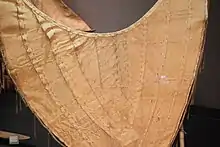
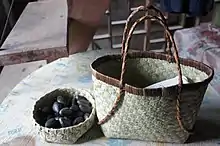
Pandanus leaves are used for handicrafts. Artisans collect the leaves from plants in the wild, cutting only mature leaves so that the plant will naturally regenerate. The leaves are sliced into fine strips and sorted for further processing. Weavers produce basic pandan mats of standard size or roll the leaves into pandan ropes for other designs. This is followed by a coloring process, in which pandan mats are placed in drums with water-based colors. After drying, the colored mats are shaped into final products, such as placemats or jewelry boxes. Final color touch-ups may be applied.
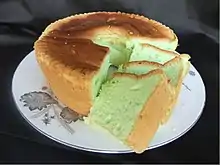
Pandan leaves from Pandanus amaryllifolius are used widely in Southeast Asian and South Asian cuisines to add a distinct aroma to various dishes and to complement flavors like chocolate. Because of their similarity in usage, pandan leaves are sometimes referred to as the "vanilla of Asia."[26][27][28] Fresh leaves are typically torn into strips, tied in a knot to facilitate removal, placed in the cooking liquid, then removed at the end of cooking. Dried leaves and bottled extract may be bought in some places. Finely sliced pandan leaves are used as fragrant confetti for Malay weddings, graves etc.
Pandan leaves are known as daun pandan in Indonesian and Malay; dahon ng pandan (lit. "pandan leaf") or simply pandan in Filipino; 斑蘭 (bān lán) in Mandarin; as ใบเตย (bai toei; pronounced [bāj.tœ̄j]) in Thai, lá dứa in Vietnamese; pulao pata in Bengali; and rampe in Sinhalese and Hindi.
In Sri Lanka, pandan leaves are used heavily in both vegetable and meat dishes, and are often grown in homes. It is common practice to add a few pieces of pandan leaf when cooking red or white rice as well.
In Southeast Asia, pandan leaves are mainly used in sweets such as coconut jam and pandan cake. In Indonesia and Malaysia, pandan is also added to rice and curry dishes such as nasi lemak. In the Philippines, pandan leaves are commonly paired with coconut meat (a combination referred to as buko pandan) in various desserts and drinks like maja blanca and gulaman.[29]
In Indian cooking, the leaf is added whole to biryani, a kind of rice pilaf, made with ordinary rice (as opposed to that made with the premium-grade basmati rice). The basis for this use is that both basmati and pandan leaf contains the same aromatic flavoring ingredient, 2-acetyl-1-pyrroline. In Sri Lanka, pandan leaves are a major ingredient used in the country's cuisine.[30]
Kewra (also spelled Kevda or Kevada) is an extract distilled from the pandan flower, used to flavor drinks and desserts in Indian cuisine. Also, kewra or kevada is used in religious worship, and the leaves are used to make hair ornaments worn for their fragrance as well as decorative purpose in western India.[21]
Species with large and medium fruit are edible, notably the many cultivated forms of P. tectorius (P. pulposus) and P. utilis. The fruit is eaten raw or cooked.[31] Small-fruited pandanus may be bitter and astringent.[31]
Karuka nuts (P. julianettii) are an important staple food in New Guinea.[32] Over 45 cultivated varieties are known.[33] Entire households will move,[34] and in some areas will speak a pandanus language at harvest time.[35][36] The taste is like coconut[32][33][37] or walnuts.[38]
Throughout Oceania, almost every part of the plant is used, with various species different from those used in Southeast Asian cooking. Pandanus trees provide materials for housing; clothing and textiles including the manufacture of dilly bags (carrying bags), fine mats or ‘ie toga; sails,[39] food, medication, decorations, fishing, and religious uses.
Selected species
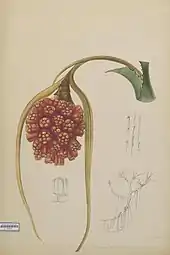
Note: several species previously placed in Pandanus subgenus Acrostigma are now in the distinct genus Benstonea.
- Pandanus aldabraensis H.St.John
- Pandanus amaryllifolius Roxb. ex Lindl. – pandan
- Pandanus balfourii Martelli
- Pandanus barkleyi Balf.f.
- Pandanus boninensis Warb.
- Pandanus candelabrum P.Beauv.
- Pandanus carmichaelii R.E.Vaughan & Wiehe
- Pandanus ceylanicus Solms
- Pandanus christmatensis Martelli
- Pandanus clandestinus Stone
- Pandanus conglomeratus Balf.f.
- Pandanus conoideus Lam.
- Pandanus decastigma B.C.Stone
- Pandanus decipiens Martelli
- Pandanus decumbens Solms
- Pandanus drupaceus Thouars
- Pandanus elatus Ridl.
- Pandanus eydouxia Balf.f.
- Pandanus fanningensis H.St.John
- Pandanus forsteri C.Moore & F.Muell.
- Pandanus furcatus Roxb.
- Pandanus gabonensis Huynh
- Pandanus glaucocephalus R.E.Vaughan & Wiehe
- Pandanus halleorum B.C.Stone
- Pandanus heterocarpus Balf.f.
- Pandanus iceryi Horne ex Balf.f.
- Pandanus incertus R.E.Vaughan & Wiehe
- Pandanus joskei Horne ex Balf.f.
- Pandanus julianettii Martelli - karuka
- Pandanus kaida Kurz
- Pandanus kajui Beentje
- Pandanus lacuum H.St.John ex B.C.Stone
- Pandanus laxespicatus Martelli
- Pandanus livingstonianus Rendle - Tropical Africa
- Pandanus microcarpus Balf.f.
- Pandanus montanus Bory
- Pandanus multispicatus Balf.f.
- Pandanus odorifer (Forssk.) Kuntze[40]
- Pandanus palustris Thouars
- Pandanus parvicentralis Huynh
- Pandanus prostratus Balf.f.
- Pandanus pyramidalis Barkly ex Balf.f.
- Pandanus rigidifolius R.E.Vaughan & Wiehe
- Pandanus sechellarum Balf.f.
- Pandanus spathulatus Martelli
- Pandanus spiralis R.Br. – Australian screwpine
- Pandanus tectorius Parkinson ex Du Roi – thatch screwpine
- Pandanus tenuifolius Balf f.
- Pandanus teuszii Warb.
- Pandanus thomensis Henriq.
- Pandanus tonkinensis B.C.Stone
- Pandanus utilis Bory – common screwpine
- Pandanus vandermeeschii Balf.f.
- Pandanus verecundus Stone
See also
- Domesticated plants and animals of Austronesia – Ancient expansion of agriculture
- Wa – Type of outrigger canoe from the Caroline Islands - vessels of the Caroline Islands which traditionally had pandanus mat sails
- Screw pine craft of Kerala
References
- "Pandanus Parkinson". World Checklist of Selected Plant Families. Royal Botanic Gardens, Kew. Retrieved 22 October 2018.
- "Search results — The Plant List". Theplantlist.org. Retrieved 18 December 2014.
- Warren L. Wagner, Derral R. Herbst, and S. H. Sohmer. Manual of the Flowering Plants of Hawai’i. 2 Vols. University of Hawaii Press. 1990. ISBN 0-8248-1152-6.
- "Australian Plant Names Index". Anbg.gov.au. Retrieved 19 November 2014.
- "JOBS- Assistant Botanist (Palms and Pandans) at RBG (Kew)". European Distributed Institute of Taxonomy. 2009. Archived from the original on 25 October 2013. Retrieved 15 October 2013.
- David C. Hyndman (1984). "Ethnobotany of Wopkaimin Pandanus significant Papua New Guinea plant resource". Economic Botany. 38 (3): 287–303. doi:10.1007/BF02859007. S2CID 32883085.
- Harold St. John (1968). "Revision of the genus Pandanus Stickman, part 29. New Papuan species in the section Microstigma collected by C. E. Carr" (PDF). Pacific Science. 22 (4): 514–519. hdl:10125/12577.
- "Archived copy". Archived from the original on 2005-09-06. Retrieved 2005-10-10.CS1 maint: archived copy as title (link)
- "Pandanus Trees in Australia". Gondwananet.com. Retrieved 2012-09-24.
- Meyen, Franz Julius Ferdinand (1846). Outlines of the Geography of Plants: With Particular Enquiries Concerning the Native Country, the Culture, and the Uses of the Principal Cultivated Plants on which the Prosperity of Nations is Based, Volumen 7. Ray Society. Retrieved 2012-09-24.
- "Factsheet - Pandanus monticola". Keys.trin.org.au. Retrieved 18 December 2014.
- "Pandanus" (PDF). Stumpman.com.au. Archived from the original (PDF) on 29 November 2014. Retrieved 18 December 2014.
- Reginald Edward Vaughan & P. O. Wiehe (1953). "The genus Pandanus in the Mascarene Islands". Journal of the Linnean Society of London, Botany. 55 (356): 1–33. doi:10.1111/j.1095-8339.1953.tb00001.x.
- Ugolino Martelli (1908). "The Philippine species of Pandanus". Philippine Journal of Science. 3 (2): 59–72.
- "Pandanus tectorius (pandanus)" (PDF). Agroforestry.net. Retrieved 2012-09-24.
- "pandanus - definition of pandanus by the Free Online Dictionary, Thesaurus and Encyclopedia". Thefreedictionary.com. Retrieved 2012-09-24.
- "Microsoft Word - 5-Seychelles formaté_RM.doc" (PDF). Fao.org. Retrieved 2012-09-24.
- "The mangrove vegetation of the Atlantic Coast of Africa: a review". Epubs.scu.edu.au. Retrieved 18 December 2014.
- "Drift Seeds And Drift Fruits : Seeds That Ride The Ocean Currents". Waynesword.palomar.edu. Retrieved 18 December 2014.
- "Revision of the Genus Pandanus Stickman, Part 5 Pandanus of the Maldive Islands and the Seychelles Islands, Indian Ocean" (PDF). Scholarspace.manoa.hawaii.edu. Retrieved 18 December 2014.
- López González, Ginés A. (2006). Los árboles y arbustos de la Península Ibérica e Islas Baleares: especies silvestres y las principales cultivadas. Mundi-Prensa. Retrieved 2012-09-24.
- Ramón de Mesonero Romanos, Gervasio Gironella, Vicente Castelló, Angel Fernández de los Ríos, Francisco Navarro Villoslada, Manuel de Assas y de Ereńo, José Muńos Maldonado, Eduardo Gasset y Artime - Google Libros (1852). Semanario pintoresco espańol. Retrieved 2012-09-24.CS1 maint: uses authors parameter (link)
- D. Agustín Yañez y Girona (1845). Lecciones de historia natural: Botánica. Impr. de Benito Espona y Blay. Retrieved 2016-10-20.
- Benjamin C. Stone (1992). "The New Guinea species of Pandanus section Maysops St. Johns (Pandanaceae)". Blumea. 37 (1): 31–61.
- "West Papua - Mining". Cs.utexas.edu. Retrieved 2012-09-24.
- "How to Cook With Pandan, the Vanilla of Southeast Asia". Saveur. Retrieved 28 April 2018.
- "Discover Pandan Leaves, The Vanilla Of Southeast Asia". Asian Inspirations. Retrieved 28 April 2018.
- Wan, Yan Ling. "Grocery Ninja: Pandan, the Asian Vanilla". SeriousEats. Retrieved 28 April 2018.
- "Buko Pandan". About Filipino Food. 2016-11-30. Retrieved 28 April 2018.
- "Cooking With Kurma - Glossary". kurma.net.
- Miller, C.D.; Murai, M.; Pen, F. (1956). "The Use of Pandanus Fruit As Food in Micronesia". Pacific Science. 10. Archived from the original on 2015-10-04. Retrieved 2014-09-03.
- Lim, Tong Kwee (2012). "Pandanus julianettii". Edible Medicinal And Non-Medicinal Plants. 4. Springer. pp. 128–130. doi:10.1007/978-94-007-4053-2_17. ISBN 978-94-007-4053-2. OCLC 822591349.
- Stilltoe, Paul (1983). Roots of the Earth: Crops in the Highlands of Papua New Guinea. Manchester, UK: Manchester university Press. ISBN 978-0-7190-0874-0. LCCN 82-62247. OCLC 9556314.
- Bourke, Richard Michael (May 1988). Taim hangre: variation in subsistence food supply in the Papua New Guinea highlands (PDF). Australian National University. OCLC 224338489. Retrieved 27 September 2018.
- Franklin, Karl J. (September 1972). "A Ritual Pandanus Language of New Guinea". Oceania. 43 (1): 66–76. doi:10.1002/j.1834-4461.1972.tb01197.x. OCLC 883021898.
- Franklin, Karl J.; Stefaniw, Roman (1992). "The 'Pandanus Languages' of the Southern Highlands Province, Papua New Guinea - a further report" (PDF). In Dutton, Tom (ed.). Culture change, language change - case studies from Melanesia. Pacific Linguistics. C-120. Canberra: Department of Linguistics Research School of Pacific Studies THE AUSTRALIAN NATIONAL UNIVERSITY. pp. 1–6. doi:10.15144/PL-C120.1. ISBN 978-0858834118. ISSN 0078-7558. OCLC 260177442. Retrieved 25 October 2018.
- Zebua, Lisye Iriana; Purnamasari, Vita (26 January 2018). "Oil of Pandan Kelapa Hutan (Pandanus jiulianettii Martelli): Physicochemical Properties, Total Phenols, Total Carotene, Vitamin E and Antioxidant Activity" (PDF). Jurnal Biologi Udayana. 21 (2): 71–77. doi:10.24843/JBIOUNUD.2017.vol21.i02.p05. ISSN 2599-2856. OCLC 7347063503. Retrieved 20 October 2018.
- Purwanto, Y.; Munawaroh, Esti (2010). "Etnobotani Jenis-Jenis Pandanaceae Sebagai Bahan Pangan di Indonesia" [Ethnobotany Types of Pandanaceae as Foodstuffs in Indonesia]. Berkala Penelitian Hayati (in Indonesian). 5A: 97–108. doi:10.5072/FK2/Z6P0OQ. ISSN 2337-389X. OCLC 981032990. Archived from the original (PDF) on 29 October 2018. Retrieved 25 October 2018.
- McCoy, Michael (1973). "A Renaissance in Carolinian-Marianas Voyaging". Journal of the Polynesian Society.
As of 1973, all canoes on Satawal were using dacron sails sewn by the men themselves. Most Carolinian canoes had used canvas acquired during the Japanese presence in the islands. The people of Satawal, however, were reluctant to switch from the cumbersome pandanus-mat sails, probably because canoes and voyaging were included in the elaborate pre-Christian taboo system. Christianity took hold on Satawal during the decades after World War II, and the Islanders then used canvas. When I and Gary Mount, as Peace Corps volunteers, demonstrated the obvious superiority of dacron over canvas with only a 4-inch square sample, the men agreed to purchase sails for the canoes of the island. As word of the superiority of dacron spread, the people of Ifalik, Elato, Woleai, Pulusuk, Pulap and Puluwat have equipped at least one canoe on each island with dacron.
- "Pandanus odorifer". IUCN Red List of Threatened Species. Retrieved 18 December 2014.
Further reading
- Germplasm Resources Information Network: Pandanus
- Sorting Pandanus names
- Wagner, W. L., Herbst, D. R., & Sohmer, S. H. (1990). Manual of the flowering plants of Hawai`i.
- Pandanus species of the Wet Tropics of Queensland, Australia photos and text by Dave Kimble
- Pneumatophores on Pandanus solms-laubachii - photo essay
- Northernmost pandanus in the world, in the Azores Islands, photo.
- Pandanus simplex fruit eaten by Varanus olivaceus, Polillo Island, Philippines.
- "Hala: The Hawaiian Aphrodisiac" Article by Shannon Wianecki describing Hawaiian cultural uses for pandanus. Maui No Ka 'Oi Magazine Volume 15 Number. 1 (Jan 2011).
External links
| Look up pandanus in Wiktionary, the free dictionary. |
![]() Media related to Pandanus at Wikimedia Commons
Media related to Pandanus at Wikimedia Commons
